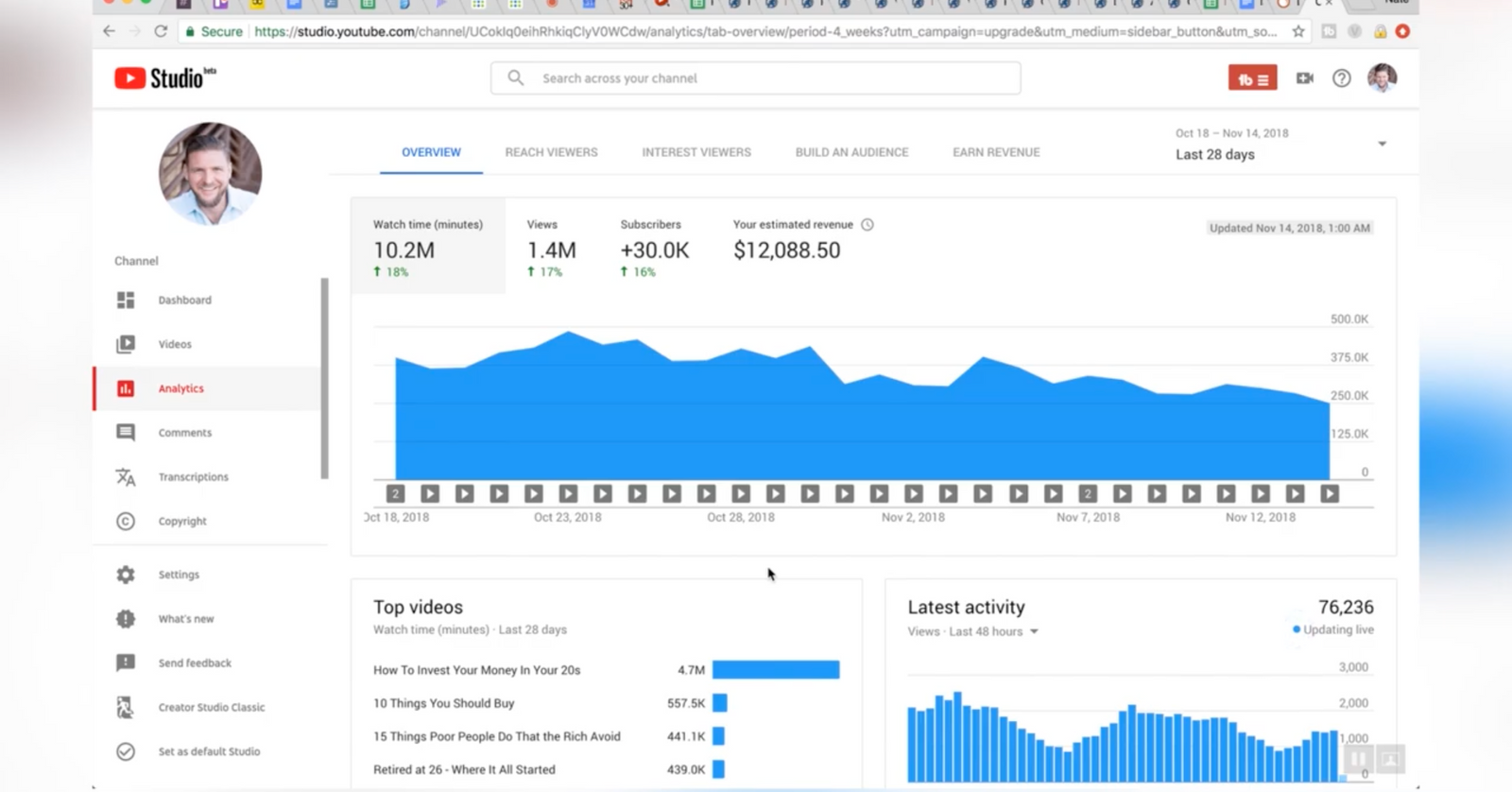YouTube Analytics is a powerful tool that provides creators with insights into how their videos are performing. It's like having a backstage pass to understand the audience better. By using this feature, YouTubers can dive deep into various metrics that reveal important information about viewer engagement, demographics, and overall channel performance. This knowledge can help creators tailor their content to better suit their audience's preferences and improve their channel's growth.
With YouTube Analytics, you can track:
- Watch time: See how long viewers are watching your videos.
- Traffic sources: Understand where your views are coming from.
- Audience retention: Know how many viewers stick around to watch your videos.
- Demographics: Get insights into the age, gender, and location of your audience.
- Engagement metrics: Analyze likes, comments, and shares of your videos.
In short, YouTube Analytics is essential for any YouTuber looking to refine their strategy and foster a deeper connection with their viewers. With this data at your fingertips, you can make informed decisions that drive growth and success on the platform.
Understanding Viewer Privacy on YouTube

When it comes to privacy, YouTube takes the protection of viewer information seriously. Many creators wonder whether they can see who exactly has watched their videos. The short answer is: no, they can't. YouTube maintains strict privacy policies that ensure individual viewer identities remain anonymous, even while providing creators with a wealth of data about their audience.
Here’s a closer look at the key elements of viewer privacy on YouTube:
- Anonymity: YouTubers can’t see specific user profiles or names of those who watch their videos. They get aggregated data instead.
- Aggregated data: Creators receive general statistics, such as total views, average watch duration, and location data, but not individual viewer information.
- Engagement indicators: While they can see likes, comments, and shares, these actions don’t reveal who is behind them.
This commitment to viewer privacy fosters a safe environment for users, encouraging them to engage freely with content without fear of being tracked or identified. For YouTubers, understanding this aspect is crucial for managing expectations and focusing on improving their content rather than worrying about individual viewers.
Also Read This: How to Watch YouTube on a School Computer: A Complete Guide
What Information Youtubers Can Access

When it comes to understanding their audience, YouTubers have access to a wealth of information through YouTube Analytics. This powerful tool provides creators with various insights that help them tailor their content and engage their viewers more effectively.
Here are some key pieces of information that YouTubers can access:
- Viewer Demographics: YouTubers can see the age, gender, and location of their viewers. This data helps them understand who is watching their videos and allows them to create content that resonates with their audience.
- Watch Time: This metric shows the total time viewers spend watching videos. It’s crucial for gauging how engaging a video is. High watch times often lead to better rankings in search results.
- Traffic Sources: YouTubers can find out how viewers discovered their videos—whether through search, suggestions, or external websites. This information is invaluable for optimizing promotional strategies.
- Engagement Metrics: This includes likes, comments, and shares. High engagement often indicates that viewers are connecting with the content, which can also boost visibility on the platform.
- Retention Rate: This shows how long viewers stay engaged with a video before dropping off. Understanding where viewers lose interest can help creators refine their content.
In short, while YouTubers can't see exactly who viewed their videos, they have access to a treasure trove of data that helps them understand their audience better.
Also Read This: How to Know If a Song on YouTube Is Copyrighted: Identifying Copyrighted Music
Limitations of YouTube Viewer Data

While YouTube provides a plethora of analytics, there are important limitations to the data available to creators. Understanding these constraints is crucial for YouTubers seeking to maximize their channel's potential.
Here are some notable limitations:
- No Individual Viewer Identity: YouTubers cannot see specific usernames or identities of viewers. This privacy measure means they can't track who watched their videos, only aggregate data.
- Limited Real-Time Data: Analytics data may not be updated in real-time. It can sometimes take hours or even days for changes in view count and engagement metrics to reflect accurately in the dashboard.
- Geographic Data Aggregation: While YouTubers can see general location information, it’s often presented in broad categories—like countries or regions—rather than precise cities.
- Inconsistent Metrics Across Videos: What works for one video may not apply to another, making it challenging to draw universal conclusions. Each video's performance can vary significantly based on numerous factors.
- Limited Historical Data: YouTube may not provide access to historical data for all videos. This can make long-term trend analysis difficult.
In essence, while YouTube Analytics offers valuable insights, these limitations mean that creators must rely on broader trends rather than precise data points about their audience's viewing habits.
Also Read This: How to Charge Your Rose Without a Magnetic Charger on YouTube: A Simple Guide
Impacts of Viewer Anonymity on Content Creators

The anonymity of viewers on YouTube has a profound impact on content creators. While it offers freedom for viewers to express their opinions without fear of judgment, it also creates challenges for creators who seek to build a community around their content.
Here are some key impacts:
- Engagement Levels: Anonymity can sometimes lead to lower engagement. When viewers can hide behind a screen, they may be less likely to interact through comments or likes, which are vital for creators to gauge viewer interest.
- Constructive Feedback: On the flip side, anonymity can encourage more honest feedback. Viewers might feel more comfortable sharing their thoughts without personal attribution, leading to valuable insights for creators.
- Trolls and Negative Comments: Unfortunately, the veil of anonymity also breeds negativity. Many creators face trolling or harsh criticisms that could be demotivating, impacting their mental health and content quality.
- Community Building: Building a loyal community becomes tricky when viewers are anonymous. Creators often strive to foster connections, and when they can't identify their regular viewers, it can feel less personal.
Content creators must navigate these complexities, balancing the benefits and challenges that viewer anonymity brings to their channels.
Also Read This: How to Upload YouTube Videos to Instagram: A Comprehensive Guide
How Youtubers Can Use Analytics Effectively
YouTube provides a treasure trove of analytics that can help creators understand their audience better and improve their content. Making sense of these metrics is crucial for growth.
Here are some effective ways to utilize YouTube analytics:
- Identify Demographics: Understanding who your viewers are—age, gender, location—can guide your content strategy. For instance, if most of your audience is in a specific age group, tailor your topics to their interests.
- Track Watch Time: Analyzing watch time helps you determine which parts of your videos keep viewers engaged. If you notice a drop-off at a certain point, consider adjusting your pacing or content structure.
- Engagement Metrics: Look at likes, shares, and comments to evaluate how well your content resonates. High engagement often indicates that your audience finds value in your videos.
- Traffic Sources: Understanding where your viewers come from—search, suggested videos, or external sites—can help you optimize your promotional strategies and focus on high-performing channels.
By harnessing the power of analytics, YouTubers can make informed decisions that enhance their content and foster a stronger connection with their audience.
Also Read This: Are YouTube Shorts Worth It? An In-Depth Look at the Value of YouTube Shorts for Creators and Viewers
Can YouTubers See Who Viewed Their Videos?
YouTube has become a platform where creators share their content with millions of viewers worldwide. A common question among YouTubers is whether they can see who specifically has viewed their videos. The answer is nuanced and involves understanding YouTube's privacy policies and analytics tools.
While YouTubers cannot see the individual identities of viewers, they have access to extensive analytics that provides insights into their audience. Here are the key features of YouTube analytics:
- Views: Creators can see the total number of views their videos receive.
- Watch Time: This shows how long viewers are engaging with the video.
- Audience Demographics: Creators can access information about the age, gender, and location of their viewers.
- Traffic Sources: This indicates where viewers found the video, whether through search, suggested videos, or external links.
- Engagement Metrics: Likes, comments, and shares can be tracked, giving creators insight into how audiences are interacting with their content.
However, YouTube prioritizes user privacy, which means individual viewer identities remain anonymous. This anonymity allows viewers to watch videos without being tracked, fostering a sense of security and freedom on the platform.
In summary, while YouTubers cannot see who viewed their videos individually, they have a wealth of information about their audience's behavior, preferences, and engagement levels. This data can help them tailor their content to better meet the needs of their viewers and grow their channels effectively.
Conclusion: Balancing Privacy and Engagement
The balance between viewer privacy and content creator engagement is crucial on platforms like YouTube. While anonymity protects users, the data available to creators helps them understand and connect with their audience, fostering a more engaging environment.
 admin
admin








